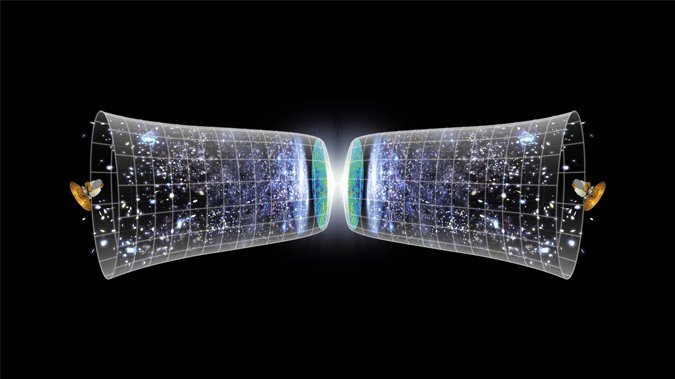-
Posts
12519 -
Joined
-
Last visited
-
Days Won
32
Content Type
Profiles
Forums
Events
Posts posted by Moontanman
-
-
The constipated composer tried and tried but he couldn't finish the last movement.
0 -
2 minutes ago, Phi for All said:
#5 -- Einstein developed a theory about space. It was about time, too!
At least three of them are funny!
0 -
I heard that physicists only have five jokes...
0 -
7 minutes ago, Airbrush said:
This is from your source:
"Jupiter’s equatorial field, at 4.3 gauss, is more than 20 times stronger than Saturn’s. If one represents Saturn’s magnetic field as produced by a simple current loop with a specified magnetic moment, then that magnetic moment is about 600 times Earth’s, whereas Jupiter’s magnetic moment is 20,000 times Earth’s."
Can anyone explain what a "magnetic moment" is?
There is an inconsistency. Your article says Jupiter's field is more than 20 times stronger than Saturn's, but it also says that Saturn's is 600 times Earth's, whereas Jupiter's is 20,000 times Earth's. 20,000/600 = 33 times stronger at Jupiter than at Saturn. So I suppose 33 is more than 20 times? What is more accurate?
You got me on that, I simply googled the strengths of Jupiter vs Saturn magnetic fields.
0 -
7 minutes ago, geordief said:
If only the same could be said of ticks(on the bell end).
There is a spider for that.
Sorry about all my oil puns. They were crude. I promise to be more refined.
1 -
I have a friend that writes songs about sewing machines. She’s a Singer songwriter or sew it seams
1 -
1 hour ago, Airbrush said:
Every planet and moon in our solar system is strange in its' own unique way. Every world, even every asteroid, is VERY different from all the others. Titan is a freak, like all the others. What about Jupiter's powerful magnetic field is 34 times as strong as Saturn's?
"Jupiter's magnetic field is...about 20,000 times stronger than Earth's."
"Saturn's...is...about 580 times stronger than Earth's...."
-ChatGPT
Now that is a significant difference! If it were accurate,
https://www.britannica.com/place/Saturn-planet/The-magnetic-field-and-magnetosphere
QuoteAt Saturn’s one-bar “surface” level, the maximum polar field is 0.8 gauss (north) and 0.7 gauss (south), very similar to Earth’s polar surface field, while the equatorial field is 0.2 gauss, compared with 0.3 gauss at Earth’s surface. Jupiter’s equatorial field, at 4.3 gauss, is more than 20 times stronger than Saturn’s.
1 -
1 hour ago, J.C.MacSwell said:
Trump of course would somehow claim it's just fake pews...
GROAN!
1 -
-
I need to write a story about bigfeet... yeah that's the ticket bigfeet have big... feet? Just a story told by Natives to scare children guys...
0 -
10 minutes ago, Airbrush said:
I asked your question of ChatGPT and here is what it said:
"Planetary history, including factors like past impacts, volcanic activity, and geological processes, can affect a moon's ability to maintain an atmosphere. Titan has a complex geological history, including processes like cryovolcanism, which can release gases and contribute to atmospheric density. Jupiter's moons have different geological histories and processes that have led to their current atmospheric compositions and densities. While Titan's dense atmosphere is influenced by factors like its distance from the Sun, composition, and geological processes, Jupiter's moons have different characteristics that result in thinner atmospheres. Each moon's unique combination of factors determines its atmospheric properties."
While accurate its not very satisfying, I still have questions but I suspect that answering my questions would take a book like manuscript at least. I struggle with figuring out what is fundamentally different about the Saturn Titan system and the Jupiter Galilean moons system. Gravity is similar on all five moons, composition is similar, temps are similar, cryovolcanism is similar. I wonder if there is a book about this concept or even papers going into detail about this, it would be a very interesting read. I do have my own speculations about this but they are just speculations.
0 -
-
-
There is a fine line between a numerator and a denominator. Only a fraction of people understand this.
1 -
-
2 hours ago, exchemist said:
I wonder if that could be an effect caused by a mix of reddish and greenish light, appearing to the eye as a yellow tint. I don't think anything in blood will actually fluoresce, not least because the UV will be attenuated under water more than visible light.
But the way light is attenuated by seawater seems to be quite complicated. The red end of the visible spectrum seems to be absorbed more than the green and blue, but UV is also absorbed. And then there is the competing phenomenon of scattering which will scatter the blue more than the red.
The attenuation of light by water depends on whether it is fresh or marine as well, spending many years growing live coral required an understanding of how light and water "slide past" each other, even the glitter effect can have a strong influence on coral growth. The glitter effect allows for a more intense amount of light reaching further into the water. UVa penetrates far enough for coral to need chemicals to turn that UV into visible light, it allows the UV light to be used for photosynthesis and give many corals their bright colors... in fact I used black lights to influence coral to produce more intense colors. Light plus water equals some interesting phenomena.
0 -
1 hour ago, TheVat said:
That chloroplasts were using these wavelengths was news to me, as well. One of those facts which, once you are aware of it, everything makes more sense. Especially in how foliage is optimizing its absorption within a shaded canopy where it needs to make the most of whatever light is getting through. Nature finds a way. A plus one to Charon for bringing this...to light.
It does bring some things into focus that I have wondered about as well!
18 hours ago, Genady said:Hmmm... My blood is just dark green there. Not fluorescent at all.
17 hours ago, exchemist said:Oh I see, because of the light at such a depth. Why fluorescent, though?
I've given this some more thought and I wonder if the florescent part could have been because I was just at the limit of red light and might have had a bit of yellow left in the glitter flashing around the deck of the liberty ship I was exploring.
0 -
 0
0 -
4 minutes ago, CharonY said:
Added two reviews in the post above. What I heard as student was, I believe, from a textbook related to bioenergetics, but I cannot recall the title (too long ago, likely in German). I only remember because it was fairly counter-intuitive, considering what was taught in high school. But considering what I learned about cellular efficiency since then, it makes a lot of sense.
Here are the abstracts from the links above:
Thank you, learning is why I am here!
0 -
5 minutes ago, Ken Fabian said:
A different opinion here. I expect that the light from other stars will still have a lot of energy across the whole visible spectrum, that eg Blue stars don't make only blue nor have a pronounced lack of red light in the spectrum and Chlorophyll a and b would work just fine.
Despite the amount of energy available to Earth plants between Red and Blue they have not evolved photosynthesis that utilises Green effectively, despite the great abundance of green light - the limitations may be in the kinds of photosynthesis chemistry that work and the other, non chlorophyll sorts of photosynthesis (some not doing CO2 to O2) are less effective. Maybe plants elsewhere will manage with Red and Blue photosynthesis (and look green like here) because those kinds of photosynthesis are easier for biochemistry to achieve.
You do make a good point, the color of a star reflects its peak output, the fact that the star emits a range of light with just the peak defining its color. Our own sun should, by that peak color thinking, be greenish but there are no green stars, the rest of the sun's spectrum washes out the green peaks.
I tried to look this up but no joy, too many pages of the color of stars based on their spectrum on Google but... I saw recently where it is thought that if the Earth was placed around a red star or a blue blue star the color of the star would appear close to what we see from earth due to the peak temp being a peak that ignores the rest of the spectrum. Our own eyes would probably fool us into seeing a moreor less yellow sun in the sky. Evidently googling this requires more finesse than I have.
Just now, CharonY said:Not really a plant person, but I think it is a bit of a misconception that plants do not use green light effectively. It is just utilized slightly differently. One important finding is that green light penetrates deeper into tissue, providing energy for CO2 fixation in deeper within leaves. Studies also suggest that because of that (and because of the rather steep absorption profile, this deeper penetration is more effective rather than trying to absorb more blue/red light closer to the surface. I think there are quite a few studies out there regarding the overall quantum efficiency at different wavelengths and different intensities in relation to plant architecture and distribution of chloroplasts, but I think the the idea that the rather simplistic idea of low absorptance of green light and associated low levels of CO2 assimilation that is sometimes still taught is school is a fair bit outdated (and goes back to studies in the 70s, I believe).
But again, not my field of expertise but there is a rather large body of literature on this topic.
I would like to see a source for this please, it goes against everything I know about plants and photosynthesis.
0 -
58 minutes ago, Genady said:
Hmmm... My blood is just dark green there. Not fluorescent at all.
17 minutes ago, exchemist said:Oh I see, because of the light at such a depth. Why fluorescent, though?
I honestly have no clue, I know that at depth red light is gone and my blood was bright green with a yellowish florescence to it. I try to take care not to cut my self underwater but that one time I gashed myself pretty good and bled like a stuck pig. The liberty ship I was diving on was full of sharp metal and swimming around through the ship was likely to get you cut at least slightly. On a positive side I did manage to get some interesting glass glass jugs that had been sunk as garbage when the ship was intentionally sunk.
I remember quite clearly swimming across the deck with sunlight glinting all-around me and being surrounded by a cloud of fluorescent green blood.
0 -
2 minutes ago, exchemist said:
Blood? In plants? Or are you thinking of haemolymph in crustaceans? That is blue/green, but not because of anything to do with light absorption.
No I was talking about my blood, if you ever get cut below 30 feet or so the blood will be fluorescent green!
0 -
3 minutes ago, iNow said:
Sanitation workers?
I stand corrected!
0 -



.png.821376ae3b3bca6c51c8c66bf5e5738f.png)
.png.3d5b71316950b9d861f407a44e97a498.png)

.png.f24cb895998b60557d2058517b7bbc92.png)
.thumb.png.58449f9fb9361a4af64c3a67b6b22007.png)
The Official JOKES SECTION :)
in The Lounge
Posted
download (1).html